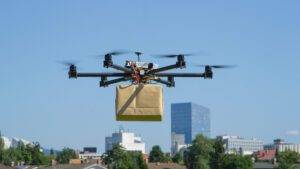Drones could soon be delivering urgent medical supplies, as new regulations are set to revolutionise their operations near buildings and infrastructure.
The Civil Aviation Authority is poised to unveil proposals on Tuesday that would grant drones the freedom to fly alongside other aircraft and venture beyond the sight of the pilot. This development marks a significant milestone, opening avenues for drones to play a vital role in swiftly delivering medicines to emergencies and conducting inspections of critical infrastructure like railway lines, power lines, and roads.
Flying beyond the line of sight will enable operators to rely solely on the drone’s built-in camera, transmitting real-time footage to the controls. Presently, drones are confined to “segregated airspace” and can fly out of sight of the remote pilot only in tightly regulated trials.
Under the proposed rules, pilots would need to operate drones at low altitudes and in close proximity to buildings or infrastructure to mitigate risks to other aircraft. Kevin Woolsey, head of remotely piloted aircraft at the CAA, lauded these plans as a “positive step towards unlocking the next stage for drone flying in the UK.”
These changes, forming part of the government’s “future flight programme,” aim to facilitate the integration of next-generation aircraft like electric vertical take-off and landing aircraft (eVtol) and cargo drones into the airspace. Moreover, the aviation industry anticipates the widespread adoption of flying taxis within the next decade.
Nats, the UK’s air traffic controller, recently conducted its inaugural live simulation of integrating eVtol aircraft into commercial operations without disruption. They are developing an app-based platform to streamline flight plans, automating processing, amendments, and approvals without the need for direct communication with air traffic controllers.
Industry experts foresee initial adoption of flying taxis by airlines to offer premium transfers for first-class passengers from airports to city centers. Over time, the cost of such trips is expected to decrease substantially, potentially challenging traditional taxi services, particularly for longer journeys.
Read more:
Drones could soon be making urgent medical deliveries in new CAA proposals
























